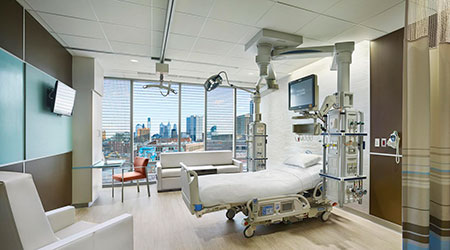Traditionally, two fundamental priorities drove flooring selection- appearance and affordability. However, the healthcare industry demands flooring that goes above and beyond these features to meet the critical needs of patients and employees. Specification of flooring in healthcare environments requires consideration on multiple levels, including acoustics, ergonomics and safety, to deliver required performance.
What is performance flooring?
Performance flooring responds to users in its environment in a way that supports and enhances their activities. In a majority of spaces, the floor is taken for granted as a passive surface, not a performing one. Flooring in almost any space can have a positive impact on the performance and well-being of people using it. There are specific characteristics, such as acoustics, ergonomics and safety, that can guide designers to select the best floor for a space, both for performance and its design and cost-effectiveness.
The precise composition of a performance floor can be tailored to react to the various needs of users in different spaces. Recent trends favor removing carpet and replacing it with hard surfaces. While traditional hard surfaces can present challenges, performance flooring offers solutions to benefit acoustics, ergonomics and safety. For example, in a hospital corridor, performance flooring responds to footsteps, voices and moving equipment to protect patients from noise while delivering the right combination of comfort and mobility for staff.
Recently, performance floors are being engineered to combine the hygienically safe benefits of hard surfaces with the acoustic and ergonomic attributes of soft surfaces to form an innovative flooring option – fusion-bonded resilient flooring. Fusion-bonded resilient flooring is a single product comprised of a hard surface, such as vinyl or calendared rubber, fusion-bonded to a vulcanized composition rubber performance backing. This breakthrough flooring technology delivers the performance benefits required by facility designers while offering modern surface options.
Performance flooring: Acoustics
Occupant health and wellness are increasingly important aspects of the built environment, and ensuring positive acoustic surroundings is a critical part of the design process. Acoustics can negatively affect the hospital occupant experience in many ways including stress from noise, sleep disturbance, worker productivity, speech intelligibility, privacy and even patient outcomes.
Performance flooring is vital for positive acoustic experience and control of impact noise from footsteps, rolling carts, and other surface-generated noise in a healthcare setting. It also reduces sound from both inside and outside the space where floor impacts or interactions occur.
Acoustical underlayment is the most common method of improving the impact of noise reduction of a floor. The rubber performance backing of the fusion-bonded resilient flooring helps reduce impact noise transmitted to adjacent spaces, as well as surface-generated noise within the space where the impact occurs.
Performance flooring: Ergonomics
A high-performance surface can provide support, prevent fatigue and injury and promote good mobility. Ergonomic flooring balances the absorption of force and the return of energy, appropriately supporting activities performed in a given space. For example, in a healthcare space, you would require a floor that is both cushioned for employees who spend long hours on their feet, but hard enough to withstand frequent movement and heavy equipment.
Performance flooring should consider three phases of footfall to ensure surfaces provide ergonomic support and mitigate injury. They include foot impact or force reduction (as the foot impacts the surface it deflects, absorbing energy); the loading phase of footfall (the accumulation of stored energy in the middle of the foot strike); and energy restitution (stored energy that’s released into the person when moving forward). The ideal surface for any space will achieve a balance between force reduction and energy restitution. Balancing the physical characteristics of the flooring based on the specific needs of the space for safety, mobility and ergonomic response is important when designers select flooring.
Performance floors: Safety
When patients in hospital environments are in treatment, it’s critical they avoid slips or falls to avoid longer hospital stays and higher bills. Engineered performance flooring can reduce the force of impact which may mitigate injury when falls do occur. Slip resistance is typically the most familiar component of safety performance in flooring, but in the event should a fall occur, engineered performance flooring should reduce the force of impact on the patient.
Work-related musculoskeletal disorders typically account for one-third of all occupational injuries and illnesses reported, constituting the largest job-related injury problem in the United States. A performance floor should contribute to reducing impact hazards in the space, balanced with enhancing the ability of people to move freely.
Floors can also be designed for other uses that relate to safety. For example, changes of color and pattern can be designed to indicate changes of floor level, aid in wayfinding or assist people with visual impairments. Floors are major components of design in healthcare environments, where creative use of color and aesthetics has proven to enhance patient experience, support healing and improve outcomes.
A floor can do more
A thoughtfully engineered performance floor using state-of-the-art advancements in materials and manufacturing can enhance the acoustics, ergonomics and safety in healthcare facilities. Engineered options, like fusion-bonded resilient flooring, can offer traditional benefits beyond performance capabilities. These floors can offer design versatility, durability, and ease of maintenance. At the same time, performance flooring can offer sustainability of the source materials and manufacturing practices.
Specification of performance-based flooring in a hospital environment puts patients on a solid foundation for healing and supports the long-term health of staff. Performance floors can be specified to react to employees and patients in ways that support and enhance their activities and ultimately, positively impact patient care and health outcomes.
Mark Huxta is the National Healthcare Director for Ecore.

 UF Health Hospitals Rely on Green Globes to Realize Their Full Potential
UF Health Hospitals Rely on Green Globes to Realize Their Full Potential How Healthcare Facilities Can Be Truly Disaster-Resilient
How Healthcare Facilities Can Be Truly Disaster-Resilient TriasMD Breaks Ground on DISC Surgery Center for San Fernando Valley
TriasMD Breaks Ground on DISC Surgery Center for San Fernando Valley Bigfork Valley Hospital Falls Victim to Data Breach
Bigfork Valley Hospital Falls Victim to Data Breach AI-Driven Facilities: Strategic Planning and Cost Management
AI-Driven Facilities: Strategic Planning and Cost Management